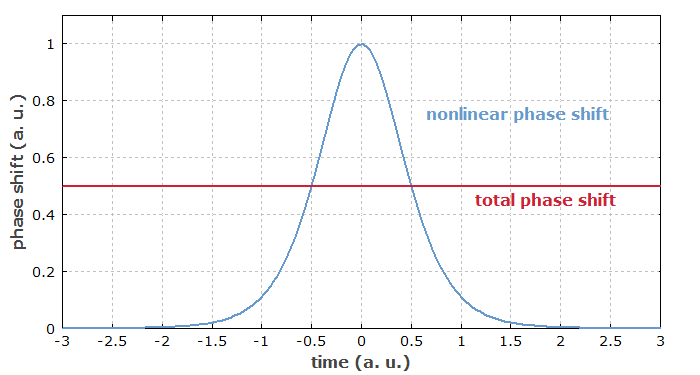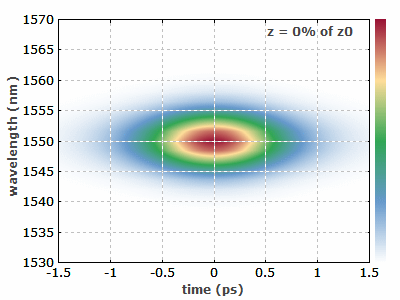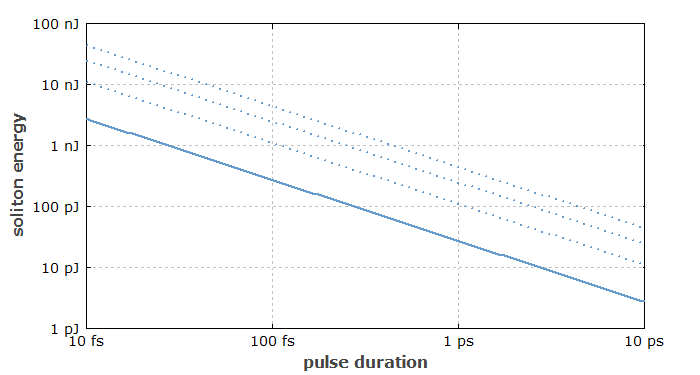Solitons
Definition: pulses with a certain balance of nonlinear and dispersive effects
More general term: light pulses
German: Solitonen
Categories: nonlinear optics, light pulses
How to cite the article; suggest additional literature
Author: Dr. Rüdiger Paschotta
In general, the temporal and spectral shape of a short optical pulse changes during propagation in a transparent medium due to self-phase modulation (resulting from the Kerr effect) and chromatic dispersion. Under certain circumstances, however, the effects of Kerr nonlinearity and dispersion can exactly cancel each other, apart from a constant phase delay per unit propagation distance, so that the temporal and spectral shape of the pulses is preserved even over long propagation distances [1, 3]. This kind of phenomenon was first observed in the context of water waves [1], but later also for light propagating in optical fibers [4].
The conditions for (fundamental) soliton pulse propagation in a lossless medium are:
- For a positive value of the nonlinear coefficient n2 (as occur for most media), the chromatic dispersion needs to be anomalous.
- The temporal shape of the pulse has to be that of an unchirped sech2 pulse (assuming that the group delay dispersion is constant, i.e. there is no higher-order dispersion):
- The pulse energy Ep and soliton pulse duration τ have to meet the following condition:

Here, the full-width at half-maximum (FWHM) pulse duration is ≈ 1.7627 × τ, γ is the SPM coefficient in rad / (W m), and β2 is the group velocity dispersion defined as a derivative with respect to angular frequency, i.e. the group delay dispersion per unit length (in s2/m).
Under the mentioned conditions, the pulse can propagate as a (fundamental) soliton (or solitary pulse) with constant temporal and spectral shape. It only acquires a phase shift which is just half the nonlinear phase shift which the peak of the pulse would experience if only the nonlinearity alone were to act on it. This soliton phase shift is constant over time or frequency, i.e., it does not lead to a chirp or to spectral broadening. In most situations, it is therefore not relevant.

Example: Solitons in Standard Telecom Fiber
As a quantitative example, solitons in standard telecom fibers (single-mode fibers for the 1.5-μm spectral region) can be considered. Assuming the common SMF-28e fiber of Corning, the effective mode area is 85 μm2 at 1550 nm wavelength, resulting in a nonlinear coefficient of 1.43 mrad/(W m). (The nonlinear index is assumed to be 3 × 10−16 cm2/W.) The chromatic dispersion at 1550 nm is +16.2 ps/(nm km), corresponding to −20 660 fs2/m. Using the above equation, we find that 1-ps solitons have to have a pulse energy of 51 pJ, corresponding to a peak power of 45 W.
For 10 times shorter solitons with a 100-fs duration, the pulse energy rises 10-fold to 510 pJ, whereas the peak power becomes 100 times larger (4.5 kW).
Stability of Solitons
The most remarkable fact is actually not the possibility of the mentioned balance of dispersion and nonlinearity, but rather that soliton solutions of the nonlinear wave equation are very stable: even for substantial deviations of the initial pulse from the exact soliton solution, the pulse automatically “finds” the correct soliton shape while shedding some of its energy into a so-called dispersive wave, a weak background which has too little intensity to experience significant nonlinear effects and temporally broadens as a result of dispersion. Solitons are also very stable against changes of the properties of the medium, provided that these changes occur over distances which are long compared with the so-called soliton period (defined as the propagation distance in which the constant phase delay is π/4). This means that solitons can adiabatically adapt their shape to slowly varying parameters of the medium. Also, solitons can accommodate to some amount of higher-order dispersion; they then automatically adjust their shape to achieve the mentioned balance under the given conditions.
Higher-order Solitons
If the pulse energy is the square of an integer number times the fundamental soliton energy, the pulse is a so-called higher-order soliton. Such pulses do not have a preserved shape, but their shape varies periodically, with the period being the above-mentioned soliton period.


Higher-order solitons can break up into fundamental solitons under the influence of higher-order dispersion and other disturbing effects. They are by far not as stable as fundamental solitons.
Importance of Solitons
Fundamental soliton pulses are technically very important, in particular for long-distance optical fiber communications and in mode-locked lasers (→ soliton mode locking). In the latter situation, soliton-like pulses can be formed when the typically lumped pieces of dispersion and nonlinearity in the laser cavity are sufficiently weak. Solitons are also applied in various techniques for pulse compression using optical fibers; examples are adiabatic soliton compression and higher-order soliton compression.
Soliton Self-Frequency Shift
When propagating in an optical fiber, soliton pulses are subject not only to the Kerr nonlinearity, but also to stimulated Raman scattering. For very short solitons (with durations of e.g. <100 fs), the optical spectrum becomes so broad that the longer-wavelength tail can experience Raman amplification at the expense of power in the shorter-wavelength tail. This causes an overall spectral shift of the soliton towards longer wavelengths, i.e., a soliton self-frequency shift [5, 6, 12, 16, 17]. The strength of this effect depends strongly on the pulse duration, since shorter solitons exhibit a higher peak power and a broader optical spectrum. The latter is important because the Raman gain is weak for small frequency offsets. During propagation, the rate of the frequency shift often slows down, because the pulse energy is reduced and the pulse duration increased [17].
The soliton self-frequency shift can be exploited for reaching spectral regions which are otherwise difficult to access. By adjusting the pulse energy in the fiber, it is possible to tune the output wavelength in a large range [10, 11, 13–15].
Simulation of Soliton Propagation
Soliton propagation, possibly with additional disturbing effects, can be investigated with numerical simulations (→ pulse propagation modeling). There are also some analytical tools, e.g. soliton perturbation theory, involving dynamic equations for small deviations of pulse parameters from those of the ideal soliton.
Dissipative Solitons
The solitons as discussed above arise in a situation where the pulse does not exchange energy with the fiber. These (ordinary) solitons are therefore called conservative solitons. A much wider range of phenomena is possible when dissipative effects also come into play. For example, so-called dissipative solitons may arise even for normal chromatic dispersion in combination with a positive nonlinear index, if there is in addition a spectral bandpass filtering effect and also optical gain (amplification) to compensate for the energy losses in the filter. Another possible dissipative effect is related to saturable absorption.
There is a similar phenomenon in the resonator of a passively mode-locked laser, containing not only a fiber, but also other optical components such as a spectral bandpass filter and a saturable absorber. If each of the relevant effects is sufficiently weak within one resonator round trip, the resulting dynamics are similar as if all the effects would be occurred in a distributed fashion within the fiber. In that sense, one may describe the circulating pulse in certain mode-locked fiber lasers as dissipative solitons.
Note that strictly speaking we can never have a conservative soliton in a passively mode-locked laser, because we always have some saturable absorption and laser gain. A consequence of that is that the pulse energy and pulse duration in the steady state are fixed, whereas solitons in a fiber could have a wide range of energies and durations, where only their product is fixed. These fixed parameters are actually characteristic for dispersive solitons. However, as the dominant pulse shaping effects are often the conservative ones (namely dispersion and nonlinearity), one nevertheless doesn't call these pulses dissipative solitons.
Spatial Solitons
Apart from the temporal solitons as discussed above, there are also spatial solitons. In that case, a nonlinearity of the medium cancels the diffraction, so that a beam with constant beam radius can be formed even in a medium which would be homogeneous without the influence of the light beam. Temporally, the beam properties can be constant. The Kerr effect is far too weak to realize a spatial soliton with constant optical power under practically achievable conditions, but photorefractive effects can be utilized.
Questions and Comments from Users
Here you can submit questions and comments. As far as they get accepted by the author, they will appear above this paragraph together with the author’s answer. The author will decide on acceptance based on certain criteria. Essentially, the issue must be of sufficiently broad interest.
Please do not enter personal data here; we would otherwise delete it soon. (See also our privacy declaration.) If you wish to receive personal feedback or consultancy from the author, please contact him e.g. via e-mail.
By submitting the information, you give your consent to the potential publication of your inputs on our website according to our rules. (If you later retract your consent, we will delete those inputs.) As your inputs are first reviewed by the author, they may be published with some delay.
Bibliography
| [1] | J. S. Russell, “Report on waves”, in Report of the 14th meeting of the British Association for the Advancement of Science, p. 331 (1844) |
| [2] | V. E. Zakharov and A. B. Shabat, “Exact theory of two-dimensional self-focusing and one-dimensional self-modulation of waves in nonlinear media”, Sov. Phys. JETP 34, 62 (1972) |
| [3] | A. Hasegawa and F. Tappert, “Transmission of stationary nonlinear optical pulses in dispersive dielectric fibers. I. Anomalous dispersion”, Appl. Phys. Lett. 23, 142 (1973), doi:10.1063/1.1654836 |
| [4] | L. F. Mollenauer, R. H. Stolen, and J. P. Gordon, “Experimental observation of picosecond pulse narrowing and solitons in optical fibers”, Phys. Rev. Lett. 45 (13), 1095 (1980), doi:10.1103/PhysRevLett.45.1095 |
| [5] | F. M. Mitschke and L. F. Mollenauer, “Discovery of the soliton self-frequency shift”, Opt. Lett. 11 (10), 659 (1986), doi:10.1364/OL.11.000659 |
| [6] | J. P. Gordon, “Theory of the soliton self-frequency shift”, Opt. Lett. 11 (10), 662 (1986), doi:10.1364/OL.11.000662 |
| [7] | L. F. Mollenauer et al., “Soliton propagation in long fibers with periodically compensated loss”, IEEE J. Quantum Electron. 22 (1), 157 (1986), doi:10.1109/JQE.1986.1072858 |
| [8] | N. N. Akhmediev et al., “Stable soliton pairs in optical transmission lines and fiber lasers”, J. Opt. Soc. Am. B 15 (2), 515 (1998), doi:10.1364/JOSAB.15.000515 |
| [9] | V. N. Serkin and A. Hasegawa, “Novel soliton solutions of the nonlinear Schrödinger equation model”, Phys. Rev. Lett. 85 (21), 4502 (2000), doi:10.1103/PhysRevLett.85.4502 |
| [10] | X. Liu et al., “Soliton self-frequency shift in a short tapered air–silica microstructure fiber”, Opt. Lett. 26 (6), 358 (2001), doi:10.1364/OL.26.000358 |
| [11] | N. Nishizawa and T. Goto, “Widely wavelength-tunable ultrashort pulse generation using polarization maintaining optical fibers”, J. Sel. Top. Quantum Electron. 7 (4), 518 (2001), doi:10.1109/2944.974222 |
| [12] | J. Santhanam and G. P. Agrawal, “Raman-induced spectral shifts in optical fibers: general theory based on the moment method”, Opt. Commun. 222, 413 (2003), doi:10.1016/S0030-4018(03)01561-X |
| [13] | K. S. Abedin and F. Kubota, “Widely tunable femtosecond soliton pulse generation at a 10-GHz repetition rate by use of the soliton self-frequency shift in photonic crystal fiber”, Opt. Lett. 28 (19), 1760 (2003), doi:10.1364/OL.28.001760 |
| [14] | E. R. Andresen et al., “Tunable light source for coherent anti-Stokes Raman scattering microspectroscopy based on the soliton self-frequency shift”, Opt. Lett. 31 (9), 1328 (2006), doi:10.1364/OL.31.001328 |
| [15] | M.-C. Chan et al., “1.2- to 2.2-μm tunable Raman soliton source based on a Cr:forsterite laser and a photonic-crystal fiber”, IEEE Photon. Technol. Lett. 20 (11), 900 (2008), doi:10.1109/LPT.2008.922339 |
| [16] | J. H. Lee et al., “Soliton self-frequency shift: experimental demonstrations and applications”, IEEE J. Quantum Electron. 14 (3), 713 (2008), doi:10.1109/JSTQE.2008.915526 |
| [17] | A. A. Voronin and A. M. Zheltikov, “Soliton self-frequency shift decelerated by self-steepening”, Opt. Lett. 33 (15), 1723 (2008), doi:10.1364/OL.33.001723 |
| [18] | P. Grelu and N. Akhmediev, “Dissipative solitons for mode-locked lasers”, Nature Photon. 6, 84 (2012), doi:10.1038/nphoton.2011.345 |
| [19] | F. Leo et al., “Dynamics of one-dimensional Kerr cavity solitons”, Opt. Express 21 (7), 9180 (2013), doi:10.1364/OE.21.009180 |
| [20] | T. Herr et al., “Temporal solitons in optical microresonators”, Nature Photon. 8, 145 (2014), doi:10.1038/nphoton.2013.343 |
| [21] | T. J. Kippenberg et al., “Dissipative Kerr solitons in optical microresonators”, Science 10, 361 (6402) (2018), doi:10.1126/science.aan8083 |
| [22] | R. Paschotta, case study on higher-order solitons |
See also: Kerr effect, dispersion, soliton period, higher-order solitons, adiabatic soliton compression, pulse compression, Gordon–Haus jitter, pulse propagation modeling, chromatic dispersion, self-phase modulation, The Photonics Spotlight 2008-04-02
and other articles in the categories nonlinear optics, light pulses
 |



If you like this page, please share the link with your friends and colleagues, e.g. via social media:
These sharing buttons are implemented in a privacy-friendly way!